Weak pressure of hot water from the gas column: reasons for the decrease in pressure + cleaning instructions
In order to bathe in hot water and avoid possible expensive repairs, you need to properly operate the equipment, and also periodically clean the collected dirt for prevention. Scale, clogging, filter wear - these and other factors can lead to the fact that there will be a weak pressure of hot water from the gas column or the household appliance will completely fail. I would not want to be left without hot water at the most inopportune moment, do you agree?
But what to do in case of low pressure, how to detect the cause and eliminate it? In this article, we consider in detail the possible problems that impede the normal operation of the water heater, and methods for solving the problem. For clarity, the material presented will be supplemented by photos and video recommendations.
The content of the article:
Reasons for weak water column pressure
Faced with a problem of insufficient pressure? Let's see what this situation may be connected with and how to solve it correctly.
Problem # 1 - insufficient pressure on the network
Sometimes problems with weak pressure of hot water arise due to instability pipeline pressure. Especially often the inhabitants of high-rise buildings face such a difficulty.
When the pressure drops, the sensors are triggered on the water heater. Not only does the water flow poorly, but also its temperature does not rise above 50 ° C. The pressure difference at the inlet and outlet of the column, of course, should be, but not big.
If the water heater is fully operational, and the cause of the poor pressure lies in insufficient pressure in a centralized water supply system, you can influence the situation through installation accumulator suitable volume. This solution is ideal for homes and apartments with frequent blackouts.
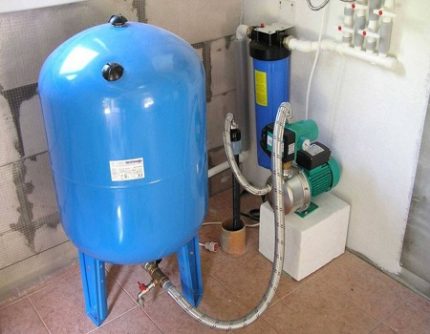
Problem # 2 - filter clogging
If the pressure in the water supply system is normal, and water is not flowing well from the gas column, then you need to look for the cause in the water heater itself. maybe clogged filter or scale formed.
And sometimes the column does not cope because of its insufficient power. Therefore, experts recommend buying gas inodometer power from 8 kW and more.
The most common problem with low pressure hot water is blockage. coarse filter. All because of old piping systems that have not seen pipe replacement and repair for years. Microparticles of various debris come to us along with water through a pipeline. The filter “brakes” them and prevents them from seeping into the gas column.
Over time, a lot of garbage is collected and the pressure of the water becomes worse. Therefore, periodically you need to clean the grid.
You can find the filter on the branch pipe of the water reducer. It looks like a regular grid. If the water pressure was strong, the filter element could bend and get inside the nozzle. The mesh should be removed and washed under running water. For the best effect, you can soak for a while in a solution of acetic acid.
Problem # 3 - scale formation
Over time, in the process of heating water on the surface of the internal elements of the column is formed scale. The rate of deposition depends on many factors: water hardness, frequency of inclusion of heating equipment.
Scale in the tubes of the heat exchanger not only reduces the pressure in the system, but also increases the amount of gas used to heat the water.
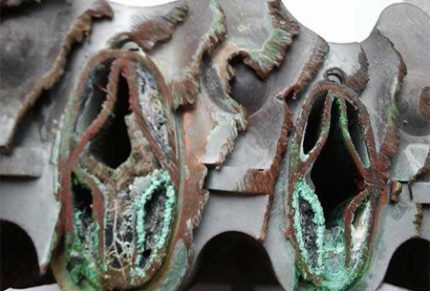
Limescale can even cause damage to the water heater. Therefore, at the first sign of scale formation, column cleaning.
Signs of scaling:
- at the outlet of the heater, poor pressure of hot water;
- after a short heating the protection is activated (thermal sensor);
- the column often turns on and off;
- water heats up for a long time.
Descale in the heat exchanger by means of purchased means or specially prepared solutions for these purposes. There are also non-chemical methods for controlling limestone deposits.
Method # 1 - citric acid + cleaning instructions
When the scum formed and the gas column is clogged, not many people know how to clean it if there is no normal water pressure. It’s most correct, of course, to seek help from professionals. But sometimes there is no time or extra money to call the master.
Therefore, many owners independently wash their water heaters from limestone deposits. A citric acid solution is used for these purposes. But you must perform this procedure carefully so as not to damage the parts of the gas device. If you smell gas, call the emergency service.
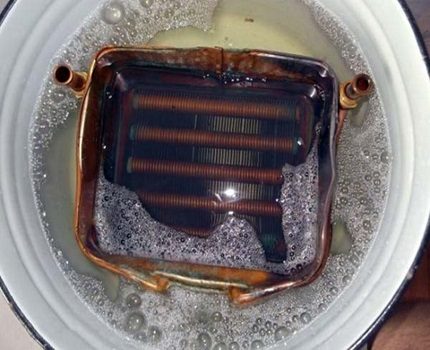
Column self-cleaning algorithm:
- We carry out preparatory work: we shut off water and gas, disconnect the water heater from the network, and drain the liquid from the equipment.
- We clean the strainer located at the inlet of the receiving unit. The net can be washed under the pressure of ordinary water. If there is calcium deposits, soak the filter in a solution of citric acid.
- In the course of treatment, we check the membrane. If deformation is detected on the part, replace it with a new one. Independently remove the membrane and reinstall not difficult, as the unit is mounted by means of threaded connections.
- We remove the heat exchanger. Do not pull it strongly, the mount may be damaged. If the nuts are sour, it is difficult to unscrew, then we take the "VD-40" or a similar product and apply it to the threaded joints. After 20 minutes, you can already try to remove the heat exchanger.
- Soak the heat exchanger in solution: 200 g of citric acid per 1 liter of water.The resulting product is poured into the radiator and left it for 10-12 hours.
- We rinse the heat exchanger with water and mount it in its place. In the process of installing parts, be sure to check the condition of the gaskets, if necessary, install new ones.
- We open the water supply, make sure that there are no leaks.
- We connect the place of connection with the gas pipe with soap and water, check for leaks.
- We connect the geyser to the mains and heat the water.
This cleaning should be done every 2 years. If the water has a high hardness, then scaling is done more often.
Citric acid is quite popular for cleaning various appliances and household appliances. So, it is often used as an effective tool for cleaning washers.
Method # 2 - using phosphoric acid
Descaling in this way requires dismantling the radiator from the gas column. To circulate the product through a radiator, you will need a special device and phosphoric acid concentrate 7-10%.
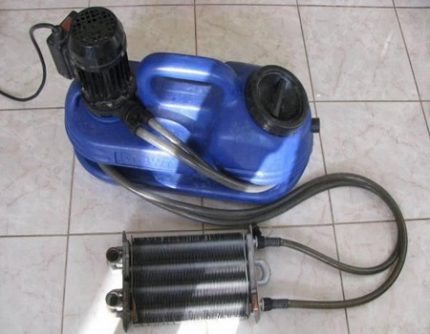
The heat exchanger removed from the column is installed on a flat surface, after which cleaning equipment with an already filled reagent is connected to it. The joints of the unit with the radiator inlet and outlet must be airtight, they can be insulated with electrical tape.
The descaling procedure takes about an hour. However, it all depends on the clogging of the radiator, if the layer of deposits is too thick, the washing time can be increased. After the heat exchanger should be thoroughly washed from phosphoric acid residues and carefully mounted in its place.
Method # 3 - descaling with hydrochloric acid
The quick descaling of the column heat exchanger can be carried out using hydrochloric acid. To do this, take two pieces of a hose or pipe with fitting: one part is connected to the radiator inlet, the second to the outlet. A funnel is attached to the first hose and raised above the level of the water heater. A 3-5% hydrochloric acid solution is slowly poured into the watering can.
During washing, foam may form. The product quickly corrodes the scale, if a strong pressure appeared at the outlet, then the deposits have already dissolved. Be sure to flush with rubber gloves; acid may injure skin.
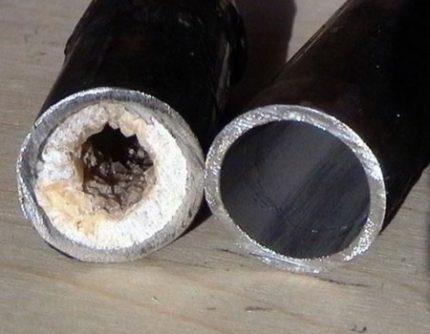
Using hydrochloric acid and other acids, getting rid of scale in a water heater is quite easy. But you should be aware that such tools can destroy metal parts, as well as their welded joints.
Therefore, it is better to flush using special equipment of a closed type and use preparations intended for cleaning. Geyser cleaning equipment is sold in many stores. It supplies the working fluid under pressure along the circuit with the desired temperature.
During processing, the use of hydrochloric acid is alternated with several solutions. Thus, it is possible to avoid the negative effect of reagents on the metal elements of the water heater. In this case, various deposits are well removed and corrosion processes are prevented.
Scale can form not only in the radiator, so from deposits you need to clean the entire path of the fluid. In the process of cleaning should take into account the characteristics of the materials of parts and components of the heater.
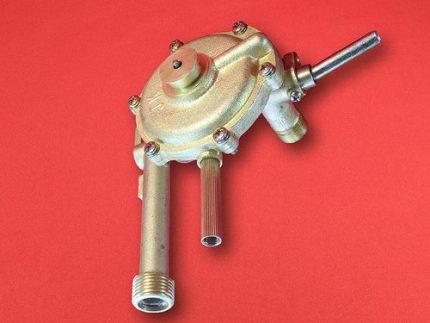
Method # 4 - use of electromagnetic technology
Descaling is done by ultrasound - electromagnetic scale converter.
There are several variations in the performance of the ultrasonic filter, which differ in power and in the way the magnetic field is formed. The plants are capable of protecting a section of the pipeline up to 2 km long from deposits.

Mount the electromagnetic converter in the area of the incoming water pipe without scale. That is, before the first start of the magnetic filter, the heat exchanger should be flushed and the water intake unit should be cleaned.
The device will generate magnetic pulses that soften the water, remove deposits and prevent the formation of new scale.
Problem # 4 - Mixer Clog
Not always a bad pressure of hot water indicates that it was the gas column that clogged, sometimes the reason lies in the mixer itself. Sometimes debris from the pipes of the heater enters the faucet. Clogging may occur in a thin rubber hose, filter, or other items.
To normalize the water pressure and eliminate the problem, you need to disassemble the mixer and wash off the accumulated dirt from the parts.
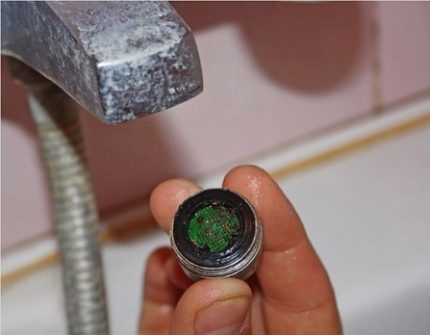
If the pressure of hot water is normal in the kitchen and the stream is weak in the bathroom, then filter clogged. After flushing, normal pressure will be restored. If the water quality is poor, then the goose filter screen must be cleaned every month.
Due to the constant heating of the water by a gas column to 70 ° C or more, it can happen rubber pad deformation in the tap. The cut part will partially block the water flow, which will lead to a decrease in pressure. Therefore, there is no need to replace gaskets here.
Prevention of scale formation in the heat exchanger
In order not to suffer with the dismantling of the heat exchanger and its descaling should operate correctly gas column.
It is easier to prevent the formation of salt deposits than to get rid of them later.
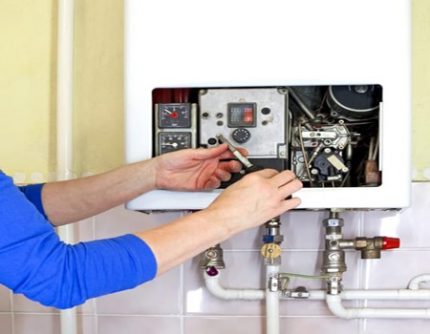
Preventive measures:
- Bathing should be in water with temperatures up to +40 ° C. Such temperature conditions are good for health, and the column is not harmful.
- A temperature of 45-50 ° C will be sufficient to wash the dishes. Water will be comfortable for the hands and the fat will dissolve well.
- Washing can also occur at a temperature of 45-50 ° C. If heavily soiled, add +5 ° C.
The process of solidification accelerates temperature conditions with intense heating up to +80 ° C. The scale begins to be deposited even on the perfectly smooth walls of the heat exchanger, and if there is roughness on the surface, then the mount becomes "reinforced concrete".
Conclusions and useful video on the topic
Visual instruction for dismantling the coarse filter:
How is the water heater cleaning with household chemicals? Look at the video:
Poor hot water pressure from a gas flow heater can occur due to many reasons. The most common is the formation of scale, which appears as a result of prolonged use. You can get rid of it both with the help of purchased expensive products, and through solutions of various acids.
It happens that the pressure disappears due to clogging of the filters of the gas column or mixer. With proper care of equipment and fixtures, problems with low pressure of hot water can easily be avoided..
Do you want to supplement the above material with useful comments or point out the reason for the decrease in water pressure, which we did not mention in our article? Write your comments in the block below, take part in discussions, express your opinion on one of the issues raised by other site visitors.

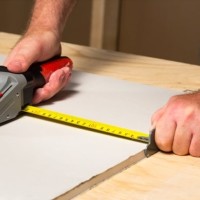 How and how to cut drywall: cutting tools + briefing on the work
How and how to cut drywall: cutting tools + briefing on the work 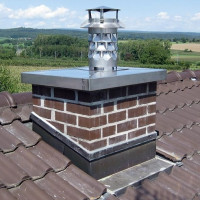 How to put a deflector on a chimney with your own hands: step-by-step instruction
How to put a deflector on a chimney with your own hands: step-by-step instruction  Bypass in the heating system: why is it needed + how to install it
Bypass in the heating system: why is it needed + how to install it 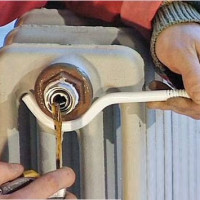 Features of flushing the heating system: an overview of the best ways
Features of flushing the heating system: an overview of the best ways 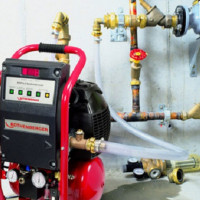 Flushing gas heating systems: flushing methods and procedure
Flushing gas heating systems: flushing methods and procedure  What should be the coolant for heating systems: fluid parameters for radiators
What should be the coolant for heating systems: fluid parameters for radiators  How much does it cost to connect gas to a private house: the price of organizing gas supply
How much does it cost to connect gas to a private house: the price of organizing gas supply  The best washing machines with dryer: model rating and customer tips
The best washing machines with dryer: model rating and customer tips  What is the color temperature of light and the nuances of choosing the temperature of the lamps to suit your needs
What is the color temperature of light and the nuances of choosing the temperature of the lamps to suit your needs  Replacement of a geyser in an apartment: replacement paperwork + basic norms and requirements
Replacement of a geyser in an apartment: replacement paperwork + basic norms and requirements